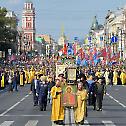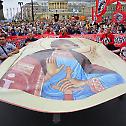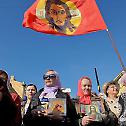150,000 march in St. Petersburg cross procession
In the northern Russian capital of St. Petersburg, two cross processions took place yesterday to commemorate the transfer of the relics of St. Alexander Nevsky, with over 150,000 people participating.
His Eminence Metropolitan Barsanuphius of St. Petersburg and Ladoga served the Divine Liturgy in Kazan Cathedral together with several other hierarchs, including His Eminence Bishop Siluan, the rector of St. Petersburg Theological Academy.
High ranking members of the Russian government, as well as foreign dignitaries, and the rector of Saint Petersburg State University attended the Liturgy.
After another Liturgy in the Holy Trinity Cathedral of the St. Alexander Nevsky Lavra, during which Serbian officials attended, the great cross procession took place along Nevsky Prospect with the Kazan Icon of the Mother of God at the front. This was all to celebrate the transfer of the relics of St. Alexander Nevsky to the city by Peter I on September 12, 1724, according to the website of the Metropolis of St. Petersburg.
St. Alexander is considered one of the greatest and most popular Russian Princes, as well as a very holy and right believing saint and a glorious knight, victorious over Swedish and German armies.
In addition to being voted the most popular Russian leader in history, the impact of the major choice made by St. Alexander on the future Russian civilization is still debated to this day.
In short, St. Alexander was at a crossroads, to submit to the Mongol armies in a political alliance, or to submit to the Pope of Rome in a spiritual union which would break the Orthodox faith.
St. Alexander began by wisely understanding what each side wanted, and therefore what he had to gain and lose in each scenario.
The Mongols did not want his faith; they cared not for what God he worshipped. It was clear what they wanted: money, and a guarantee he would not wage war on them—the easiest thing a Christian can give. What was this worthless gold and silver to the Russian Orthodox Faith?
On the other hand, the Vatican wanted money and a chance to meddle in the affairs of a people not their own.
The Mongols wanted money and peace—Pax Mongolica. The Vatican wanted money for a war against the Mongols. But the West also wanted something Alexander could not give—they wanted to take away Russia’s Orthodox faith. It was impossible not to choose, as each side wanted an alliance against the other.
St. Alexander thus chose to submit his own earthly glories to go under Mongol rule, hoping one day his descendants could gain back their political freedom with God’s blessings, as he chose to place the truth of God over the promises of men, and was famed for his saying “God is not found in power but in Truth.”
Although he chose to ally, or at least make peace with the Mongols, and fight the Western knights who subsequently invaded, St. Alexander was faithful to the classical vision of Western Civilization—a civilization supposed to be built on Greco-Roman political foundations, and Christian Faith. To read more, see this article.
It was that faith that St. Alexander fought for twice, and one of the sites of those battles with Western Catholic knights was near the foundation of the future city of St. Petersburg.
It is that same Christian faith that St. Alexander fought for that was displayed on the streets of the city yesterday.
This cross procession, and so many others, such as the 300,000 strong All-Ukrainian Cross Procession, which was thoroughly analyzed here, all serve to demonstrate to the world, that religion cannot be irrelevant when hundreds of thousands of people march long miles in the heat to celebrate God’s wonders revealed to his people via his saints
Source; Orthochristian.com










